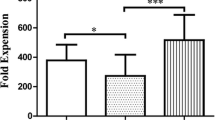Abstract
Our goal was to determine the cytotoxic activity of effector cells in lymph nodes with metastatic melanoma. Lymphocytes contained within tumor cells from metastatic lymph nodes of two patients were allowed to proliferate in recombinant IL-2 (rIL-2, 100-1,000 units/ml) after 14–21 days of culture. Each set of lymphocytes showed cytotoxicity against autologous melanoma (AM, mean 72%) at effector to target ratio of 20∶1 and K562 cells (mean 60%) using 4-h chromium-51 release assay. Using unlabeled AM and K562, each AM could partially block the activity against K562, but K562 could not block the activity against AM. These activated lymphocytes underwentin vitro sensitization (IVS) with irradiated AM cells and rIL-2 at 2-week intervals. After repeated IVS over about 50 days, each patient's lymphocytes showed cytotoxicity against AM (mean 54%) but not K562 (mean 5%,P < 0.001). These results indicate that different cytotoxic effector cells were present in the early and late phase of lymphocyte tumor culture. Repeated IVS resulted in the selection of specific cytotoxic T lymphocytes. Cold target inhibition assay demonstrated that melanoma cells contained common and individual AM-associated antigen in addition to K562-associated antigens.
Similar content being viewed by others
References
Balch, C. M., Riley, L. B., Bae, Y. J., Salmeron, M. A., Platsoucas, C. D., von Eschenbach, A. andItoh, K., 1990, Patterns of human tumor-infiltrating lymphocytes in 120 human cancers.Archives of Surgery,124, 200–205.
Grogan, T. M., Durie, B. G. M., Lomen, C., Spier, C., Wirt, D. P., Nagle, R., Wilson, G. S., Richter, L., Vela, E., Maxey, V., McDaniel, K. andRangle, C., 1987, Delineation of a novel pre-B cell component in plasma cell myeloma: Immunochemical, immunophenotypic, genotypic, cytologic, cell culture and kinetic features.Blood 70, 932–942.
Hersey, P., Bindon, C., Edwards, A., Murray. E., Phillips, G. andMcCarthy, W. H., 1981, Induction of cytotoxic activity in human lymphocytes against autologous and allogeneic melanoma cellsin vitro by culture with interleukin-2.International journal of Cancer 28, 695–703.
Knuth, A., Danowkis, B., Oettgen, H. F. andOld, L. J., 1984, T cell-mediated cytotoxicity against autologous malignant melanoma: Analysis with interleukin 2-dependent T cell cultures.Procedings of the National Academy of Sciences, USA 81 3511–3515.
Leong, S. P. L., Wang, T. F., Grogan, T. M., Dorrance, T. L. andRichter, L. C., 1989, Generation of cytotoxic T lymphocytes from tumor-draining lymph nodes against autologous melanoma in melanoma patients.Proceedings of the American Association for Cancer Research,30(1440), 363.
Mukherji, B., Wilhelm, S. A., Guha, A. andErgin, M. T., 1986, Regulation of cellular immune response against autologous human melanoma. I. Evidence for cell mediated suppression ofin vitro cytotoxic immune response.Journal of Immunology,136(5), 1888–1892.
Mukherji, B., Wilhelm, S. A., Guha, A. andErgin, M. T., 1986, Regulation of cellular immune response against autologous human melanoma. II. Mechanism of induction and specificity of suppression.Journal of Immunology,136(5), 1893–1898.
Muul L. M., Spiess, P. J., Director, E. P. andRosenberg, S. A., 1987, Identification of specific cytolytic immune responses against autologous tumor in humans bearing malignant melanoma.Journal of Immunology,138, 989–995.
Parmiani G., Anichini, A. andFossati G., 1990, Cellular immune response against autologous human malignant melanoma: Arein vitro studies providing a framework for a more effective immunotherapy?Journal of the National Cancer Institute,82, 361–370.
Rosenberg, S. A., Spiess, P. J. andSchwarz, S., 1978,In vitro growth of murine T cells. I. Production of factors necessary for T cell growth.Journal of Immunology,12, 1946–1950.
Rosenberg, S. A., Grimm, E. A., McGrogan, M., Doyle, A., Kawasaki, E., Koths, K. andMack, D. F., 1984, Biological activity of recombinant human interleukin-2 produced inE. coli.Science,223, 1412.
Rosenberg, S. A., Lotze, M. T., Muul, L. M., Leitman, S., Chang, A. E., Ettinghausen, S. E., Matory, Y. L., Skibber, J. M., Shiloni, E., Vetto, J. T., Seipp, C. A., Simpson, C. andReichert, C. M., 1985, Special report: Observations on the systemic administration of autologous lymphokine-activated killer cells and recombinant interleukin 2 to patients with metastatic cancer.New England Journal of Medicine,313, 1485–1492.
Rosenberg, S. A., Packard, B. S., Aebersold, P. M., Saloman, D., Topallian, S. L., Toy, S. T., Simon, P., Lotze, M. T., Yang, J. C., Seipp, C. A., Simpson, C., Carter, C., Bock, S., Schwatzentruber, D., Wei, J. P. andWhite, D. E., 1988, Special report: Use of tumor-infiltrating lymphocytes and interleukin-2 in the immunotherapy of patients with metastatic melanoma: A preliminary report.New England Journal of Medicine,319(25), 1676–1680.
Rosenberg, S. A., Aebersold, P., Cornetta, K., Kasid, A., Morgan, R. A., Moen, R., Karson, E. M., Lotze, M. T., Yang, J. C., Topalian, S. L., Merino, M. J., Culver, K., Miller, A. D., Blaese, R. M. andAnderson, W. F., 1990, Gene transfer into humans-Immunotherapy of patients with advanced melanoma, using tumor-infiltrating lymphocytes modified by retroviral gene transduction.New England Journal of Medicine,323(9), 570–578.
Shu, S., Chou, T. andRosenberg, S. A., 1986,In vitro sensitization and expansion with viable tumor cells and interleukin-2 in the generation of specific therapeutic effector cells.Journal of Immunology,136, 3891–3898.
Slingluff, C. L., Jr, Darrow, T., Vervaert, C., Quinn-Allen, M. A. andSeigler, H. F., 1988, Human cytotoxic T cells specific for autologous melanoma cells: Successful generation from lymph node cells in seven consecutive cases.Journal of the National Cancer Institute,80(13), 1016–1026.
Topalian, S. L., Muul, L. M. andRosenberg, S. A., 1986, Growth and immunologic characteristics of lymphocytes infiltrating human tumors.Surgical Forum 37, 390–391.
Author information
Authors and Affiliations
Additional information
This work was supported by Biomedical Research Support Grant of the University of Arizona (no. 2S07 RR05675-20), the Elsa U. Pardee Foundation Grant, partly by the Arizona Chronic Disease Research Commission and partly by CA23074 from the National Institutes of Health, Bethesda, 20892, U.S.A.
Recipient of the American Cancer Society Clinical Oncology Career Award, 1987–90.
Rights and permissions
About this article
Cite this article
Leong, S.P.L., Granberry, M.E., Zhou, Y.M. et al. Selection of cytotoxic T lymphocytes against autologous human melanoma from lymph nodes with metastatic melanoma using repeatedin vitro sensitization. Clin Exp Metast 9, 301–317 (1991). https://doi.org/10.1007/BF01753732
Received:
Accepted:
Issue Date:
DOI: https://doi.org/10.1007/BF01753732




